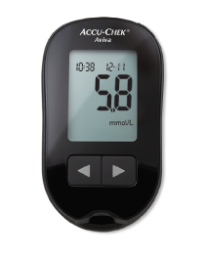Frequently Asked Questions
Checking blood sugar
As soon as a sufficient amount of blood is applied to the test strip, the Accu-Chek Aviva meter automatically detects it and begins the test, even if some yellow is still visible in the window. The only time the user needs to apply more blood is when the blood drop symbol continues to flash in the display.
The user will receive an error message if the control result is out of range.
The Accu-Chek Aviva meter automatically recognises Accu-Chek Aviva control solutions, so running a control test is easier than ever. First, wipe the tip of the control bottle. Then put the meter on a flat surface, insert the test strip, and squeeze a drop of the control solution onto the front edge of the test strip. A result appears with a flashing “L”. Press one of the arrow keys once to indicate a Level 1 control test or twice to indicate Level 2. Press the ON/OFF button to set the level in the meter. The control result and “OK” alternate in the display if the result is in range.
Meter care and batteries
The Accu-Chek Aviva meter differentiates between control solution and blood because controls have higher salt concentration. However, if the control solution evaporates or concentrates on the tip of the bottle, it could cause the meter to display an incorrect control reading.
With the Accu-Chek Aviva meter turned on and the flashing strip symbol on the display, press and hold the ON/OFF button for about 4 seconds until "set-up" and the hour is flashing on the display.
- Open the battery door on the back of the meter by pushing the tab in the direction of the arrow and pulling the door up.
- Remove the old battery. Insert the new battery with the (+) side facing up.
- Put the battery door back in place and snap it closed.
Special features
The Accu-Chek Aviva blood glucose monitoring system will work on the 3 main AST areas: forearm, palm and upper arm. Most common are palm and forearm. AST areas have a lower blood circulation than the fingertip. Therefore a change in blood glucose will show with a delay compared to blood taken from the finger tip. Please discuss with your healthcare professional before starting to practice alternate site testing.
An additional internal battery supports the clock when the main battery is removed. You can leave the battery out of the Accu-Chek Aviva meter for 72 hours and still retain the time and date. If you replace the battery within that time, the meter will ask you to verify the time and date. The internal battery will automatically recharge. If you do not replace the battery within 72 hours, the meter will retain the time and date that was stored before the 72 hours.
Up to 4 test reminders can be set per day, in 15-minute increments. At the set reminder time(s), a series of beeps will sound every 2 minutes, up to 3 times per reminder. The reminder beep will not occur if the meter is on at the set time, or if the user runs a test 15 minutes or less before the set reminder time. If the user turns on the meter while the reminder is sounding, the series of beeps for that reminder will stop.
Control test values will not be in the user-accessible memory. However, they will be stored in the downloadable memory.
Yes. Simply go into setup mode and turn the beeper off.
Test strips, coding and control tests
Before the user doses the test strip, the Accu-Chek Aviva meter runs quality checks of the strip chemistry to make sure the strip will give a valid test result. This ensures that the strip has not been exposed to outside environmental factors, such as humidity.
The target expiration date is 18 months from the date of manufacture.
Only 3 other substances in the bloodstream (galactose1, Lipaemic samples (triglycerides)2 and ascorbic acid3) can interfere with the
- Blood concentrations of galactose greater than 15mg/dL will cause overestimation of blood glucose results. Glucose values in neonates suspect for galactosemia should be confirmed by an alternate glucose methodology
- Lipemic samples (triglycerides) in excess of 1800 mg/dL may produce elevated results
- Intravenous administration or ascorbic acid that results in blood concentrations of ascorbic acid greater than 3 mg/dL will cause overestimation of blood glucose results.
All black code chips with 111 on them can be used in the Accu-Chek Aviva, Accu-Chek Aviva Nano or Accu-Chek Aviva Expert meters.
No. Accu-Chek Aviva meters are designed exclusively for use with Accu-Chek Aviva test strips.
General questions
In the UK and Ireland it is not approved for use in clinical settings, although the Accu-Chek Aviva system is cleared to test capillary, venous, arterial, and neonatal blood samples.
The
These include:
- Sample checks
- Verify the correct amount of blood is applied
- Show user if more sample is needed
- Detect whether sample is blood or control solution
- Strip checks
- Check test strips and reagent for potential damage/abuse
- Exposure to high humidity
- Scratches on strip electrodes
- Meter is designed to compensate for humidity or temperature or to produce an error message if unable to compensate
- Meter checks
- Check for variations in:
- Hematocrit
- Humidity
- Temperature
- Check for variations in:
These checks start when the meter is turned on and are complete when a blood glucose result is shown.

